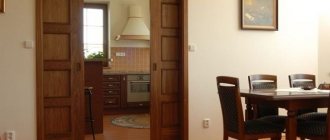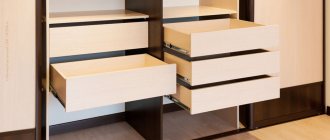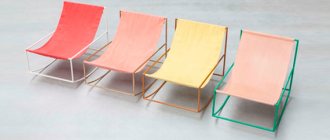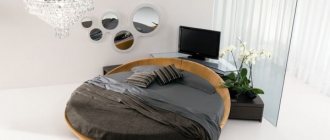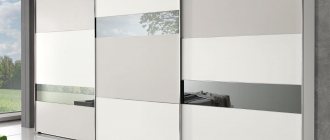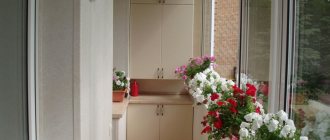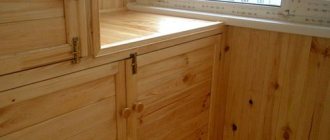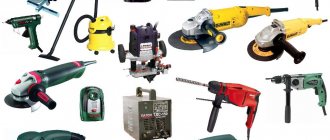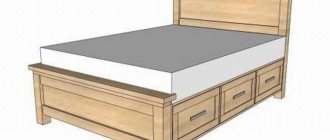Sliding door systems
You can make stylish sliding doors with your own hands.
Sliding doors differ from swing doors in the way they open. In this case, the sash moves along the facade and does not occupy additional space. The design is used both in furniture - wardrobes, and as interior doors or a screen in a niche.
Opening the sash ensures the movement of the rollers along a special guide with grooves. This method ensures ease of opening and smooth operation even with a large sash weight. On the other hand, such a mechanism presupposes the presence of technological gaps and the impossibility of a tight connection of the sash. It is installed from the wall at a distance equal to half the width of the guide, and there is no door frame at all. Therefore, the heat and sound insulation of interior sliding doors leaves much to be desired.
A big advantage of such a system is the freedom to choose material and decor. The rigidity of the door leaf is given by the frame or profile, and the vertical position is provided by the guide system itself. As a result, you can use materials for the sash that are completely unsuitable for a hinged one - polycarbonate, mirror, leather.
Suspended on the top rail
Doors on the top rail
A one- or two-way sliding system is attached to the wall at the top of the room or to the ceiling. There is no bottom rail here. The displacement is carried out due to the movement of large rollers in the upper rail. The same mechanism ensures the vertical position of the door leaf, that is, the upper carriages bear a double load.
This feature limits the choice of material. It is allowed to install light sashes of small thickness. Otherwise, the fittings fail and the door warps under its own weight. But you can’t put it too lightly: it sways in a draft.
In order for the sash to slide easily without lower rails, it is placed at some distance from the floor. Such an interior door does not provide sound or heat insulation.
Rail sliding
The two-way system includes a bottom and a top rail. The door leaf rests on the lower rollers and moves due to their movement along the grooves. The upper rollers keep the sash in a vertical position. The design, especially if it is an interior partition, is equipped with movement limiters at the bottom and stops at the top. In a wardrobe, you can do without both elements, although stoppers are usually installed.
The two-way mechanism is much more reliable and durable. Here you can install heavy doors made of solid wood, mirrors, and thick silicate glass. Another plus is better heat and sound insulation, since the mechanism includes fewer technological gaps, and the joint density can be increased due to seals.
Installing a sliding double door with your own hands is more difficult and takes more time.
If the sashes are very heavy, double guides are installed for each leaf.
Main types
Modern doors can have different designs. But on this basis, all of them can be classified into four main types:
- Doors "G". Such structures are most often installed inside buildings. Door “G” may have one or two leaves. Lattice filling is used inside them. Such doors can be assembled with or without a frame, trims and threshold.
- Type "O". These doors are structurally similar to the previous version, but have glass inserts.
- Models "K". This is a pendulum type of door, the doors of which do not pretend to be, but swing. Such structures usually have two canvases and they do not pretend, but swing. A feature of models of this type is, among other things, the absence of a threshold.
- Doors type "U". This group includes reinforced door structures. They are usually installed inside buildings at the entrance to isolated rooms, for example, apartments.
When designating a door on a drawing, all these 4 types of construction of similar products can be separately indicated.
Sliding door mechanism
Sliding doors on 2 rails
The door mechanism on rollers consists of guides and rollers with carriages. The latter constitute a sliding block and are the most important element of the structure. The system is supplemented with limiters that do not allow the sash to come out of the grooves, stoppers and decorative plugs.
There are 3 options:
- Synchronous - both doors move apart in different directions, moving along the wall. Installation of the system is complex and requires a lot of effort to synchronize. The kit includes rollers, rails, hooks, cable and fastening devices.
- Telescopic - 2 or more sashes are moved to one side, covering the facade or another sashes. Each element moves on its own rail. This system is typical for a wardrobe. Disadvantage: for 2 doors you need to install 2 rails with a total thickness of 14 cm. For a three-door design, you will need a guide 21 cm wide, which is already inconvenient.
- Tram - an option for a folding model. Usually equipped with a locking mechanism.
The fittings for the mechanism are selected according to the type of construction and the weight of the sash.
Additional designations
All symbols of doors for internal installation are described in the drawings in accordance with GOST, but as for external structures, the following symbols may be present:
- “C” – official;
- “N” – Tambour-type product or entrance;
- “L” − Manhole or hatch model.
If one of the listed letters is indicated next to the doors in the drawing according to GOST, then the letters indicating the type of construction, for example, “G”, “O”, etc. are carried a little further.
During marking, numbers are usually indicated in the third position both on the drawing of interior and entrance structures. In both cases, the numbers indicate the size of the openings. As already mentioned, they may be immediately followed by letters that indicate any secondary characteristics of the door model. In addition to the above, there may also be the following:
- “T” – fire-resistant door;
- “C” – continuous filling of the model;
- “C” - has a continuous internal filling, is equipped with a cylinder lock and a threshold;
- “Shch” – panel model;
- “P” - right sash or threshold;
- “L” – left wing;
- “B” is a moisture-resistant fabric.
If the door is metal, then in the section on the drawing it is hatched with straight parallel lines with a slope of 45 degrees, but the distance between the strokes will depend on the scale of the plan. If the product is wooden, then it is hatched with circular lines, that is, as the fibers go in the wood, thus showing the real arrangement of the layers of wood in the canvas.
Advantages and disadvantages
Zoning the living room and bedroom with a sliding structure.
Sliding interior doors have many advantages:
- The sliding system saves space, since opening the sash does not require free space.
- Ease of handling: pushing even very heavy doors is easier than opening them.
- Retractable doors are used not only as interior doors. With their help, niches are blocked and the room is zoned.
- The design is much more original and varied.
There are also significant disadvantages:
- The main disadvantage is poor heat and sound insulation. There is no possibility of a tight connection between the door leaf and the wall or frame.
- A two-way system is more reliable. However, it requires mounting guides with a total width of 7 to 14 cm on the floor. Such a threshold is very inconvenient.
- The latches on this model cannot provide protection.
The variety and decorative possibilities of sliding doors compensate for the shortcomings.
Advantages of retractable doors
Retractable interior doors have a number of undeniable advantages:
- ease of installation, allowing you to install the door structure with your own hands;
- ease of use, the door is absolutely easy to open and close;
- wide possibilities for manufacturing door panels according to individual orders;
- practicality and space saving. Retractable interior doors are indispensable in small rooms. Ideally mounted in doorways that are too narrow or wide;
- By using decorated retractable doors you can create a unique designer interior.
Sources:
- https://diy.obi.ru/articles/kak-sdelat-razdvijnie-mejkomnatnie-dveri-21338/
- https://polygalvostok.ru/razdvizhnye-dveri-iz-polikarbonata-svoimi-rukami/
- https://DekorMyHome.ru/remont-i-oformlenie/razdvijnye-dveri-svoimi-rykami-konstrykcii-i-sposoby-montaja-foto-video-cherteji.html
- https://kak-sdelano.ru/dveri/razdvizhnyie-dveri-svoimi-rukami
- https://o-dveryah.ru/razdvizhnye/otkatnye-mezhkomnatnye-svoimi-rukami/
- https://gorodverey.ru/vydvizhnye-dveri-svoimi-rukami.html
- 1
Types of guides
Metal guides for rails
For sliding interior doors, the guide is important. It is a U-shaped profile with limiters. Its standard width is 7 cm, height – no more than 3 cm. The rail is made from the following metals:
- Aluminum is a lightweight, corrosion-resistant metal. This profile wears out little, does not require maintenance or protection, and has its own pleasant color and shine. However, its mechanical strength is relatively low. Aluminum rails are only suitable for lightweight sashes.
- Steel is stronger and more durable. They serve up to 50 years. Steel hardly wears out. However, it is prone to corrosion; in order to protect the profile from rust, the steel is coated with a layer of zinc, chrome, varnish, and polymer paint. The integrity of the coating must be monitored.
Other factors are also taken into account:
- type of roller system and opening method;
- the number of parallel moving canvases - this is how the number of guides is calculated;
- the nature of the support of the sashes - if it is a single-strip system, then the upper rail must be strengthened, as it is subjected to double load.
The bottom rail, even if it is “sunk” into the floor, remains visible. Therefore, when choosing, you need to evaluate its design.
Material selection
It is important to decide: what to make the door from and what material to use for the exterior decoration.
The basis for an interior door can be the following materials:
- natural wood - it’s easy to work with, the doors are strong, beautiful and durable. Disadvantages: heavy doors, wood absorbs moisture. Often only the frame is made of wood, and other materials are used for cladding;
- MDF board - the door can consist entirely of boards, but if it is sheathed along the frame, then corrugated cardboard or other filler is placed inside. This is a cheaper material and is not afraid of moisture;
- Chipboard - consists of compressed chips glued with synthetic resins;
- plastic, glass, aluminum or stainless steel are usually used in production, but at home it is difficult to make a door out of them.
Gallery: doors made of different materials
Double glass doors are made from tempered glass and decorated with designs.
The two halves of a double-leaf plastic door with colored glass can be designed differently if one of them is rarely used
A barn door made of matte plastic is perfect for a bathroom or dressing room
The sliding door made of aluminum frame and colored plastic is beautiful, light and easy to use
Ordinary paneled doors can be made with a glass insert and highlighted in a bright color in the interior
An arched door with decorative trim will become an independent decoration of a large room
A solid wooden door with inserts made of thin MDF sheets will harmoniously fit into a classic-style room
Most often, do-it-yourself interior doors are made from wood, so you need to determine which wood is best to choose. Let's look at different breeds:
- pine - easy to process, but dries out over time; is characterized by low cost;
- alder is a more porous and soft wood, easy to process, but not resistant to rotting;
- birch is a dense and viscous wood with a beautiful structure, but is short-lived;
- oak is durable and resistant to mechanical damage, but difficult to work with because it cracks along the fibers;
- beech is durable, but is afraid of changes in temperature and humidity;
- larch - with a beautiful structure, easy to process, durable;
- walnut - with a uniform structure, strong and durable;
- maple - resistant to moisture, easy to process and polish.
The following materials are used for decorative cladding of the door leaf and frame:
- natural veneer - thinly cut sheets or strips of wood that are glued to any base. Veneer allows you to imitate solid wood;
Natural veneer has a textured surface, is easily glued to wood and can be restored
- eco-veneer is a compressed product consisting of glued wood fibers. Eco-veneer is similar to natural veneer, but costs less;
- laminate is a film made from several layers of paper. High-quality laminate looks beautiful and lasts a long time, while low-quality laminate peels off over time;
Vinyl laminate is wear-resistant, suitable for any surface, but fades in direct sunlight
- plastic - sheets of synthetic polymers. Plastic is moisture resistant and is not afraid of temperature changes, but when heated strongly it releases harmful substances;
- paint - acrylic, alkyd, nitro paint;
- varnish - allows you to preserve the structure of the wood from moisture.
The choice of materials depends on the preferences of the owners and the design of the doors.
Video: characteristics of doors made of different materials
Mounting options
Cassette door design
Parallel sliding doors can be installed in different orders. This affects the design of the mechanism and the material of the valves.
Sliding doors
The most famous option. The sash moves along its guide in both directions. If the structure has two doors, the doors move towards each other. They have a common guide. This is the best option for simple interior doors, since only 1 rail will have to be mounted on the floor, and its width is only 7 cm.
Cassette
With this opening mechanism, the doors look much more interesting. When opened, the sash moves not along the wall, but inside it. To do this, a cavity is formed in the septum. If this cannot be done, a false wall is built. In this case, the sash actually moves along the real wall, but is hidden from view in the plasterboard box.
The design can be one- or two-door.
Cascade
Implement a telescopic opening mechanism. Each leaf moves along its own guide in one direction. For a two-door design you need to install 2 rails, and for a three-door design - 3.
Cascading doors are more suitable for wardrobes. However, with a complex configuration of adjacent rooms - a box on one side, a large difference in the thickness of the walls and interior partitions - this option turns out to be more convenient.
Marking of structures
It is clear how doors of various designs are indicated in the drawings, but now it’s worth understanding the markings. Door production companies produce leaves of various sizes and this must be indicated in the drawings and markings.
According to GOST, the manufacturer indicates the dimensions of the door leaf for the opening for which it is intended, and this is also indicated on the diagram next to the door icon. In addition, the product model “O” or “G” may have two doors that are unequal in width, and then next to the doors in the drawing according to GOST, additional letters “P” and “L” are indicated, which means the right and left leaves. Also, if the structure is equipped with a threshold, this is indicated in the form of the letter “P”.
DIY installation
To install a door made of chipboard, polycarbonate, plastic panels, you don’t have to resort to the help of specialists, but follow the instructions. The main condition is to give the sash a vertical position. Therefore, in addition to a screwdriver, hammer, chisel, you need to prepare a building level and plumb line.
First of all, the upper guide is mounted to the wall.
Installation diagram:
- The profile is cut: the bottom guide for a single-door structure should be 2 times the width of the doorway. Install so that the sash completely clears the opening when opening. At the same time, on the other side, 50 mm is left near the opening.
- For a door structure, the guide is mounted so that its middle coincides with the center of the opening.
- Holes for dowels are drilled through the rail in the floor. Insert dowels and fix fasteners.
- Determine the position of the upper guide. To do this, install a canvas in the bottom rail and mark its edge on the wall. Add 70 mm to the value and make a mark; use a building level to check the horizontalness.
- A wooden beam with a cross-section of at least 50*50 cm is fixed at the mark. The upper rail is attached to it from below in the same way as the lower one.
- Install stoppers and other additional elements.
- The door leaf assembled according to the drawing is inserted into the guides: first in the upper rail, since the upper rollers are pressure rollers, then in the lower one. Check the vertical position and freedom of movement.
- A decorative strip is attached that covers the beam and the upper guide.
It is recommended not to immediately secure the top rail tightly. If the sash moves poorly, you can correct its position by changing the position of the upper rail. Final fixation is performed after achieving free displacement.
Requirements for the quality of wooden doors
We found out what symbols are provided in the drawings according to GOST for doors. But what are the requirements for the manufacture of such structures? According to GOST 475-78 standards, such structures can be manufactured with minor deviations from standard dimensions. In this case, the document indicates maximum tolerances.
Also, according to GOST 475-78, wooden doors can be produced using the following materials:
- well-dried wood;
- plywood;
- rolled metal;
- plastic assemblies;
- glass and glue.
At the same time, for those models that will subsequently be used in conditions of high humidity, it is recommended to use coniferous wood. For doors intended for installation in ordinary rooms, according to GOST, it is allowed to use deciduous material.
Homemade sliding doors
Even an ordinary door can be made into a sliding one.
For a door weighing more than 30 kg, it is necessary to make upper and lower guides
Manufacturing recommendations:
- If the door leaf weighs less than 30 kg, you can install a hanging system. If it’s more, they install a two-lane one.
- An interior door made of chipboard often has decorative inserts or overlays. If they cannot be removed, their size must be taken into account when determining the location of the bottom rail. Otherwise, the sash will not be able to fit onto the wall.
- The usual fittings are removed. It is inconvenient to move the sash using the round handle.
- Accessories are purchased taking into account the weight of the product. Door handles – taking into account the design.
- The material is preferably light but durable: chipboard, MDF, polycarbonate. Mirrors and glass are much harder to work with.
- The balance of a regular sash is not designed for this type of use. To compensate for this, the rollers are placed as far apart as possible to ensure a smooth ride.
Sliding doors are practical and convenient. They do not take up space when opened, are very decorative and easy to use. However, their heat and sound insulation performance is lower than that of swing doors.
What are vestibule, hatch and manhole doors?
Such structures belong to the class of external ones. According to GOST, standard symbols are used in the drawings of doors of this type. That is, this could be a model type icon or just an opening with a sash.
Tambour doors are usually installed after the entrance doors and are intended to retain heat in the premises of an apartment or house. Such models are often not insulated, but are complemented by a dense vestibule. Structurally, they are something like a partition with doors installed between the walls of the corridor. There are only three main types of such doors: solid, lattice and with inserts. As already mentioned, in the marking, vestibule doors, like entrance doors, are designated by the letter “H” (external).
Hatch models in buildings can be installed, for example, in attics. Such structures are manufactured at enterprises both on a metal frame and on a wooden one. In many cases, doors of this type are additionally insulated. Sometimes such models can be equipped with a folding ladder. Designs of this type are marked as “L”.
Manhole doors are designated by the same letter and are used to access the roof or any technical premises. Like hatches, they can be made of either metal or wood. Very often such structures are additionally insulated.
